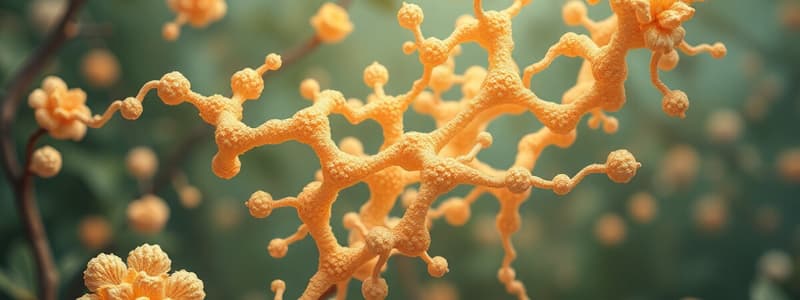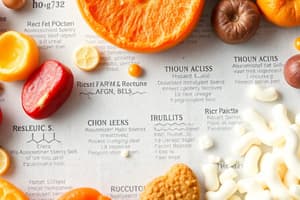Podcast
Questions and Answers
What type of bond is formed when monosaccharides join together through dehydration synthesis?
What type of bond is formed when monosaccharides join together through dehydration synthesis?
- Covalent bond
- Hydrogen bond
- Ionic bond
- Glycosidic bond (correct)
Saturated fatty acids contain one or more double bonds in their hydrocarbon chains.
Saturated fatty acids contain one or more double bonds in their hydrocarbon chains.
False (B)
What is the term for the process in which peptide bonds in proteins are broken down to form free amino acids?
What is the term for the process in which peptide bonds in proteins are broken down to form free amino acids?
Hydrolysis
A solution with a pH greater than 7 is considered _____ .
A solution with a pH greater than 7 is considered _____ .
Match the following examples with their corresponding types of carbohydrates:
Match the following examples with their corresponding types of carbohydrates:
Which of the following correctly describes hydrogen bonds?
Which of the following correctly describes hydrogen bonds?
Monomers are single molecules that can join together to form complex structures called polymers.
Monomers are single molecules that can join together to form complex structures called polymers.
In hydrolysis of carbohydrates like sucrose, what products are formed when water is added?
In hydrolysis of carbohydrates like sucrose, what products are formed when water is added?
What are the levels of protein structure from simplest to most complex?
What are the levels of protein structure from simplest to most complex?
RNA is self-replicating, just like DNA.
RNA is self-replicating, just like DNA.
What does DNA stand for?
What does DNA stand for?
A triglyceride is composed of one glycerol and ______ fatty acids.
A triglyceride is composed of one glycerol and ______ fatty acids.
Match the nitrogenous bases with their respective nucleic acids:
Match the nitrogenous bases with their respective nucleic acids:
Which of the following is involved in the process of polymerization of nucleotides?
Which of the following is involved in the process of polymerization of nucleotides?
The central dogma of molecular biology describes a one-way flow of genetic information.
The central dogma of molecular biology describes a one-way flow of genetic information.
What is the process by which ester bonds are formed in triglycerides?
What is the process by which ester bonds are formed in triglycerides?
What is the role of glycogen in animals?
What is the role of glycogen in animals?
The amino group of one amino acid bonds with the amino group of another during dehydration synthesis.
The amino group of one amino acid bonds with the amino group of another during dehydration synthesis.
What are the three main components of an amino acid?
What are the three main components of an amino acid?
Cellulose provides strength to ______ cell walls.
Cellulose provides strength to ______ cell walls.
Match the following proteins with their functions:
Match the following proteins with their functions:
What is the importance of carbon's valence of 4?
What is the importance of carbon's valence of 4?
Protein folding is not essential for its biological function.
Protein folding is not essential for its biological function.
What is the result of repeatedly joining amino acids through dehydration synthesis?
What is the result of repeatedly joining amino acids through dehydration synthesis?
What is the outcome of hydrolysis in triglycerides?
What is the outcome of hydrolysis in triglycerides?
Saturated fatty acids contain at least one double bond between carbon atoms.
Saturated fatty acids contain at least one double bond between carbon atoms.
What are the main functions of triglycerides?
What are the main functions of triglycerides?
Phospholipids consist of a glycerol, two fatty acid tails, and a ______ linked head group.
Phospholipids consist of a glycerol, two fatty acid tails, and a ______ linked head group.
Match the following lipid types to their functions:
Match the following lipid types to their functions:
Which of the following statements accurately describes hydrogen bonding?
Which of the following statements accurately describes hydrogen bonding?
Capillary action is the movement of water using cohesion only.
Capillary action is the movement of water using cohesion only.
What is the importance of buffers for living organisms?
What is the importance of buffers for living organisms?
Flashcards are hidden until you start studying
Study Notes
Hydrolysis in Proteins
- Breaks peptide bonds to produce free amino acids and short peptides
- Requires a water molecule for each broken bond
Saturated and Unsaturated Fatty Acids
- Saturated fatty acids: Hydrocarbon chains with only single bonds.
- Unsaturated fatty acids: Have one or more double bonds in the hydrocarbon chain.
Water Polarity
- Oxygen is slightly negatively charged, while hydrogen is slightly positively charged.
pH and Acidity/Alkalinity
- pH measures the relative amounts of hydrogen (H+) and hydroxyl (OH-) ions in water
- pH less than 7 is acidic
- pH greater than 7 is alkaline (basic)
- Alkalinity buffers, neutralizing acids to help maintain pH
Monomers and Polymers
- Monomer: a single molecule (building block)
- Polymer: a chain of many monomers
Carbohydrate Monomers and Polymers
- Monomers (monosaccharides): Glucose, fructose, galactose
- Polymers (disaccharides): Sucrose, maltose, lactose.
- Polysaccharides: Glycogen, starch, cellulose
Hydrogen and Covalent Bonds
- Hydrogen bond: A weak attraction between a hydrogen atom (slightly positive) and an electronegative atom (like oxygen or nitrogen) in the same or a different molecule.
- Covalent bond: A strong bond formed by the sharing of electrons between two atoms.
Carbohydrate Polymerization
- Dehydration synthesis: Monosaccharides join, releasing a water molecule and forming a glycosidic bond.
- Glycosidic bond: The covalent bond formed between two monosaccharides during dehydration synthesis.
- Example: Two glucose molecules combine to form maltose, a disaccharide.
Carbohydrate Hydrolysis
- Breaks glycosidic bonds between monosaccharides, separating complex carbohydrates into simpler sugars.
- Example: Water added to sucrose breaks it down into glucose and fructose.
Carbohydrate Functions
- Energy source: Glucose is used in cellular respiration to produce ATP.
- Energy storage: Glycogen (animals) and starch (plants) store glucose.
- Structural support: Cellulose (plant cell walls), chitin (fungal cell walls, insect exoskeletons).
- Cell signaling: Glycoproteins on cell surfaces aid in cell recognition and communication.
Importance of Carbon's Valence
- Carbon has a valence of 4, allowing it to form four covalent bonds with other atoms.
- This versatility enables the creation of long chains, rings, and complex structures, essential for life.
Amino Acid and Protein Structure
- Amino group (NH₂), carboxyl group (COOH), and a side chain (R group) are all attached to an alpha-carbon.
Amino Acid Polymerization
- Dehydration synthesis: The amino group of one amino acid bonds with the carboxyl group of another, releasing a water molecule.
- Peptide bond: The covalent bond formed between two amino acids.
- Polypeptides: Long chains of amino acids.
Enzyme Functions
- Biological catalysts: They speed up chemical reactions within cells.
- Essential for life: Crucial for all biochemical reactions, from breathing to digestion.
Protein Functions
- Antibodies: Defend against antigens (foreign invaders).
- Contractile proteins: Responsible for muscle contraction (e.g., actin, myosin).
- Enzymes: Catalyze biochemical reactions.
- Hormonal proteins: Messenger proteins (e.g., insulin).
- Structural proteins: Maintain and protect body structure (e.g., collagen).
- Storage proteins: Reserve amino acids (e.g., albumin).
- Transport proteins: Move molecules across membranes (e.g., hemoglobin).
Protein Folding
- Crucial for protein function: Folding into a specific three-dimensional conformation allows proteins to function.
- Levels of protein folding:
- Primary structure: The linear sequence of amino acids.
- Secondary structure: Local folding patterns, like alpha-helices and beta-sheets.
- Tertiary structure: The overall three-dimensional shape of a single polypeptide chain.
- Quaternary structure: The arrangement of multiple polypeptide chains in a protein complex.
DNA and RNA
- DNA: Deoxyribonucleic acid
- RNA: Ribonucleic acid
Central Dogma of Molecular Biology
- Genetic information flows from DNA to RNA to protein.
- In some cases, RNA directly translates into protein.
Nucleotide Structure
- Sugar molecule (ribose in RNA or deoxyribose in DNA)
- Phosphate group
- Nitrogenous base
DNA and RNA Comparison
- DNA: Double-stranded, longer chain of nucleotides, self-replicating.
- RNA: Single-stranded, shorter chain of nucleotides, not self-replicating.
Nitrogenous Bases
- DNA: Adenine (A), Guanine (G), Cytosine (C), Thymine (T)
- RNA: Adenine (A), Guanine (G), Cytosine (C), Uracil (U)
Nucleotide Polymerization
- Dehydration synthesis: Two nucleotides join, releasing a water molecule.
- Phosphodiester bond: The covalent bond formed between the phosphate group of one nucleotide and the sugar of the next.
Nucleic Acid Hydrolysis
- Breaks phosphodiester bonds between nucleotides.
- This can be done by nucleases, which break down DNA or RNA.
Triglyceride Composition
- Glycerol: A three-carbon molecule with three hydroxyl groups.
- Three fatty acids: Long hydrocarbon chains with a carboxyl group at one end.
Triglyceride Dehydration Synthesis
- Ester bonds: Formed between the hydroxyl groups of glycerol and the carboxyl groups of fatty acids.
- Water molecules: Released during bonding.
Triglyceride Hydrolysis
- Breaks ester bonds, releasing glycerol and three fatty acids.
- Hydrolysis can be triggered by acid and heat or biological conditions.
Saturated and Unsaturated Fatty Acids (again)
- Saturated fatty acids: No double bonds in the fatty acid chain.
- Unsaturated fatty acids: Have one or more double bonds in the fatty acid chain.
Lipid Types and Functions
- Triglycerides: Transport and store energy.
- Steroid hormones: Send messages in cells (e.g., testosterone, estrogen).
- Bile salts (from cholesterol): Help digest fats.
- Fatty acids: Metabolized to create energy.
- Phospholipids and cholesterol: Form cell membranes.
Phospholipid Composition and Roles
- Glycerol, two fatty acid tails, a phosphate-linked head group.
- Forms cell membranes: Creates a barrier between the cell's internal environment and the outside world.
- Allows compartmentalization: Enables cellular processes to occur in different parts of the cell.
Hydrogen Bonding
- Weak attraction between two atoms in different chemical bonds.
- Crucial for water's properties:
- Cohesion: Water molecules stick to each other.
- Adhesion: Water molecules stick to other surfaces.
- Capillary action: The movement of water through narrow spaces due to cohesion and adhesion.
- Surface tension: The ability of water to resist an external force.
- Universal solvent: Water's polarity allows it to dissolve many substances.
Water Density
- 1 gram per milliliter
- Less dense as a solid (ice) than as a liquid: This is why ice floats.
Water's High Heat Capacity and Heat of Vaporization
- High heat capacity: Water can absorb large amounts of heat without changing temperature significantly.
- High heat of vaporization: A large amount of heat is required to change water from a liquid to a gas.
Buffer Concept
- Resists pH changes: Buffers can absorb or release H+ ions to help maintain a stable pH.
- Essential for living organisms: Allows organisms to maintain homeostasis and function properly.
Macromolecules Based on Composition
- Carbohydrates: C, H, O
- Lipids: C, H, O (some complex lipids also contain phosphorus)
- Proteins: C, H, O, N (sometimes S)
- Nucleic acids (DNA and RNA): C, H, O, N, P (phosphorus is a key part of the phosphate backbone)
Studying That Suits You
Use AI to generate personalized quizzes and flashcards to suit your learning preferences.




